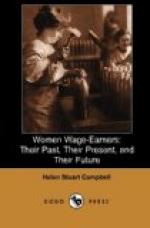Taking up the other New England reports in which reference to these evils is found, the testimony is the same. Law is often evaded or wholly set aside,—at times through carelessness, at others wilfully. The most exhaustive treatment of this subject in all its bearings is found in the report of the New Jersey Bureau of Labor for 1889, the larger portion of it being devoted to the fullest consideration of the hygiene of occupation, the diseases peculiar to special trades, and general sanitary condition and methods of working, not only in “dangerous, unhealthy, or noxious trades,” but in all. Commissioner Bishop, from whose report quotations have already been made (p. 197), gives many instances of working under fearful conditions, absolutely destructive to health and often to morals; and the report may be regarded as one of the most authoritative words yet spoken in this direction.
The Factory Inspection Law for the State of New York, in detail much the same as that of Massachusetts, is sufficiently full and explicit to secure to all workers better conditions than any as yet attained save in isolated cases. There is, however, constant violation of its most vital points; and this must remain true for all States, until the number of inspectors is made in some degree adequate to the demand. At present they are not only seriously overworked, but find it impossible to cover the required ground. The law which stands at present as the demand to be made by all factory-workers and all interested in intelligent legislation, will be found in the Appendix.
Destructive to health and morals as are often the factories and workshops in which women must work, they play far less part in their lives than the homes afforded by the great cities, where the poor herd in quarters,—at their best only tolerable shelters, at their worst unfit for man or beast. It is the tenement-house question that in these words presents itself for consideration, and that makes part of the general problem. Taking New York as illustrative of some of the worst forms of over-crowding, though Boston and Chicago are not far behind, we turn to the work of one of the closest and most competent of observers, Dr. Annie S. Daniel, for many years physician in charge of out-practice for the New York Infirmary for Women and Children. The report of this practice for 1891 includes a series of facts bearing vitally on every phase of woman’s labor. Known as an expert in these directions, her testimony was called for in the examination of 1893 into the sweating-system of New York, made by a congressional committee and now on record in a report to be had on application to the New York Congressmen at Washington.[43] For years she has watched the effects of child-labor, taking hundreds of measurements of special cases, and studying the effects of the life mothers and children alike were compelled to live. “The medical problems,” she writes, “which present themselves to the physician are so closely connected




